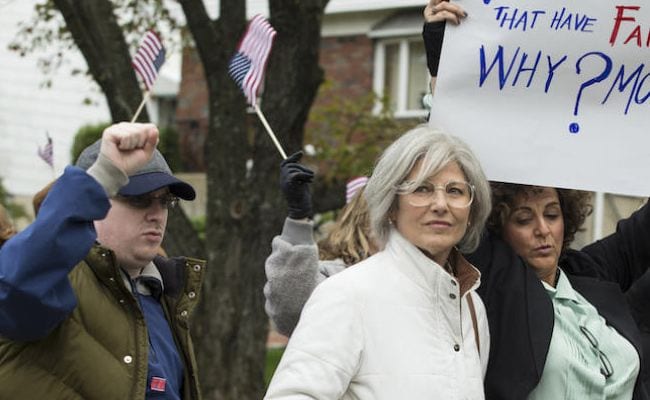
With the continuing relevance of Show Me a Hero‘s narrative to today’s racially-charged political landscape, perhaps none of the issues it had dealt with so far are as poignantly topical as its depiction of the “evolution” of mainstream racism away from direct acts of violence and explicitly degrading language to indirect action and dog-whistle coding. In its third and fourth episodes, Show Me a Hero exposes the frustrated bigotry boiling under the surface of the dog-whistle racism that continues to dominate political rhetoric.
Coded phrases like “thug”, “welfare state”, and “anchor baby” replace antiquated slurs no longer acceptable to say out loud. Instead, repressed fear of people of other races and cultures is spoken in terms of “economic consequences” and “incompatible values” in an effort to rationalize that prejudice.
The Yonkers housing crisis perfectly illustrates this transformation of racism. The people taking the “principled stand” against a few hundred units of public housing in the mostly white, east side of Yonkers, hide their bigotry behind concerns for things like degrading property values, but when their petulant complaints are invalidated by both law and public opinion, they lash out.
If there were any rationality to it at all, the white protesters might recognize their own hypocrisy in the situation. They fear violence, drugs, and crime being entering their neighborhoods, but the protests turn to destructive riots when these same protestors begin bashing in the windows on Mayor Wasicsko’s (Oscar Isaac) car and spitting in his face at city hall. The threats of violence that began seeping in during “Part Two” have finally become tangible.
In a march outside one of the housing construction sites, opposition leader Jack O’Toole (Stephen Gevedon) proclaims, “We’re letting them know they’ll never be welcome here!” The cracks in their veiled racism begin to show, and when the housing project becomes a reality, they get desperate and sloppy — the final shot in “Part Four” shows a cop discovering graffiti on a half-constructed unit of housing proudly flaunting a racial slur and “KKK”. There can no longer be any hiding of the true root of their opposition.
Nick Wasicsko (Oscar Isaac), in an admirable display of honesty in the fourth episode, acknowledges that he gave in to that fear-mongering narrative early in the housing crisis. It’s a big moment of clarity for him, helping him understand exactly what he was sacrificing in order to play politics. Unfortunately, the realization comes too late; he’s already been replaced as mayor by an angry constituency that puts segregated housing proponent and master political grandstander Hank Spallone (Alfred Molina) in office to do their dirty work.
Spallone, of course, is just as incapable of defying the law as Nick was, but he understands the deferential capabilities of political tactics, which is how he’s allowed to delay the city council’s action even further. The heavy hammer of an angry constituency will eventually crush Spallone the way it did Nick (and come down even harder on Spallone), but it will also take its time. In perhaps the single most defining exchange in the series, Judge Sand (Bob Balaban) tells Nick that “justice is not about popularity.” Without missing a beat, Nick cuts to the reality of the situation: “No, it’s not. But politics is.”
“Justice” is hard to define for some in Show Me a Hero. For the white protesters, justice means being free to live in their segregated communities; for Nick, Sand, the lawyers, and the city planners, justice means giving public housing to those who need it. But for those people who live in the projects, far from the affluent east side neighborhoods, the concept of justice is far more intangible.
These two middle episodes introduce even more characters living in low-grade public housing, and expand on the stories of those we already know, with greater emphasis on how living in these neighborhoods negatively affects their situation. Billie Rowan (Dominique Fishback) drops out of school and becomes a teenage mother before the father of her child lands in jail; Doreen Henderson’s (Natalie Paul) life falls apart after her husband unexpectedly dies and she falls into drug addiction; Norma O’Neal (LaTanya Richardson Jackson), a nurse struggling with losing her sight, is unable to get a steady in-home health aid because most are too afraid to come to her apartment.
When Yonkers’ black population marches on the east side, they chant, “No justice, no peace!” The white residents don’t relate to their definition of “justice”, so they’re comfortable ignoring the sentiment of the march, and thus ignoring that those people from the other side of the city — Nick’s “silent majority” hidden in the ghettos — even exist. Justice is a function of the law, and when the law doesn’t work for certain people, justice remains an illusion.
“Part Three” and “Part Four” of Show Me a Hero delve into the psychology of racism in a more nuanced and insightful way than we’re used to seeing on television. These episodes force us to confront the way we frame debates about race, and how our rhetoric often contributes to our sometimes oppressive, institutionally flawed society. It’s debatable how much good a miniseries like Show Me a Hero can do in a culture that handwaves the idea of white privilege as an impulse, but it’s proving more and more to be one of the most accurate depictions of modern race relations than we’ve had in some time. To those willing to engage in the discussion, that’s incredibly meaningful.

